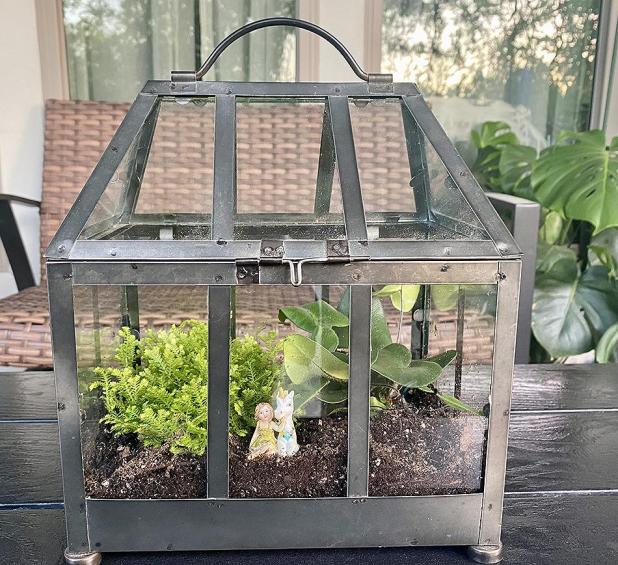
Wardian cases were used in the Victorian Age to protect plants during long-distance travel. In terrariums, water condenses on the glass and cycles back into the soil where it can be used again. If your closed terrarium collects too much moisture, allow it to dry out slightly by removing the lid to release water.
—LSU AgCenter/Heather Kirk-Ballard
Get It Growing: A terrarium is a natural ecosystem
Terrariums are a fun, low-maintenance way to bring the beauty of nature indoors and make a great addition to any home. Creating a terrarium is a fun and easy project that can be done in a short time and enjoyed for many years.
Rooted in the Victorian Age (pun intended), terrariums were popular in the mid-1800s. When Europeans traveled, they used Wardian cases, an early type of terrarium to protect plants during long-distance travel. They also were used to grow tropical plants indoors.
Terrariums are microenvironments in transparent, glass or plastic containers. They create a small ecosystem of plants. The water from the soil is taken up into the plant as it grows and released through the leaves through transpiration. The water condenses on the glass and cycles back into the soil where it can be used again.
This water cycling can allow plants to go for months without watering and creates a rainforest-like atmosphere of high humidity and warm temperatures, which are perfect conditions for many tropical houseplants.
To build a terrarium, the first thing is to pick your container. That’s the fun part! There can be many shapes and sizes. The larger the opening, the easier to work with. You can use a large glass jar, bowl or even an old fish tank. You also can use smaller containers such as mason jars, but these are harder to work with.
Terrariums can be left open or closed with a lid. Open systems need watering more often while closed ones are better able to recycle moisture already in the terrarium.
Terrariums do not have drainage holes, so be sure that you use moistened soil to begin with and add only small amounts of occasional water or mist. Some suggest adding a 2-inch layer of gravel, pebbles or perlite to the bottom to provide space for excess water to drain.
The next step is to add the moistened potting soil. Make this layer 2 to 4 inches thick, depending on the size of the container.
Now it’s time to place your plants. Plants with slow growth rates that prefer high humidity and have small leaves make good candidates for terrariums. Use plants that tolerate the same soil moisture and growing conditions. Choose a variety of plants with different textures and sizes. You can have small- to medium-sized plants with trailing and upright growing habits.
Mosses, ferns and small succulents are most commonly used. You also can choose African violets and carnivorous plants such as Venus fly traps and pitcher plants. Mosses and ferns do especially well in moist environments. Succulents prefer drier environments. You can mist ferns and mosses with a spray bottle to keep them happy. If plants have differing soil and moisture requirements, you can still pair them if you leave drier-loving plants in their individual containers.
Arrange the plants in the container, leaving enough space between them for growth. Gently press the soil around the plants to secure them in place.
Rocks, shells and stones can be added to your miniature landscape in addition to small figurines. You may also add tiny string lights or battery-operated candles for nighttime displays. Don’t leave these as a permanent feature; remove them after use to protect them from moisture.
To finish your terrarium, moisten the soil by misting heavily. Soil stuck to the glass from planting can be rinsed off by lightly running water down the glass. After watering, cover with the lid, if using. Be sure to place the terrarium in medium to bright, indirect sunlight. Heat can build when the light is too intense, so avoid direct sunlight. If excessive condensation builds up in a closed terrarium, crack the lid to allow the moisture to escape.
It is not necessary to fertilize, as that will encourage growth and quicker crowding. If you notice yellowing leaves, you can fertilize with a liquid soluble fertilizer such as a 4-4-4 mixed at one quarter of the recommended strength.
Water only when the soil becomes dry or when you see wilting. Check on the terrarium every few weeks. Plants will grow and may become crowded. You can prune plants or pull them out, replace them with a new plant and change things up.
